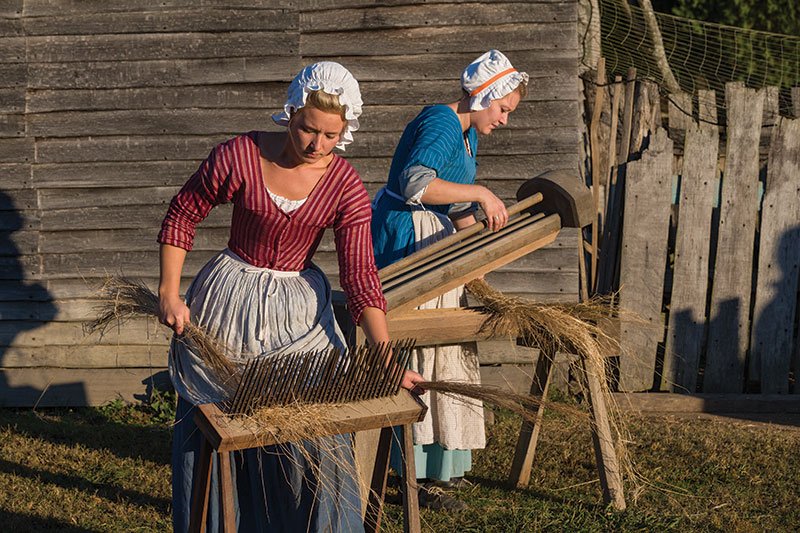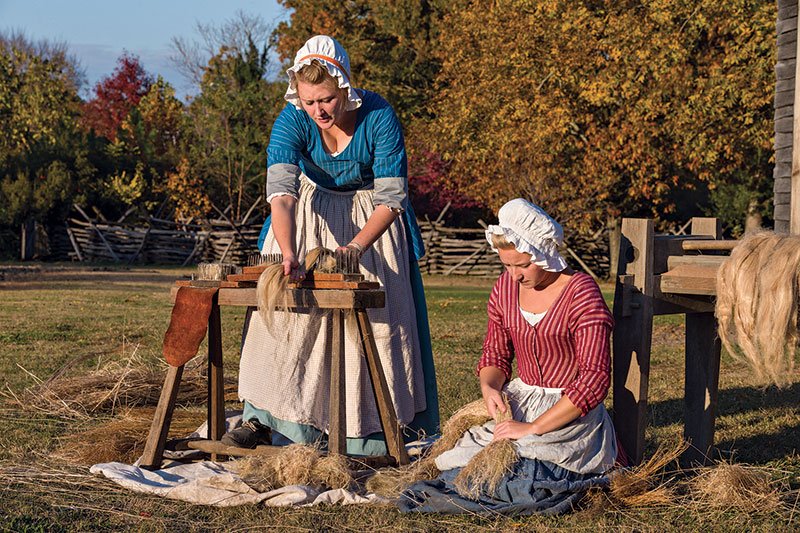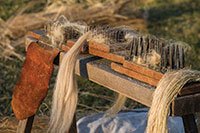Weaving and Textiles in Colonial America
Weaving in Colonial America Weaving in colonial America was originally not as heavily practiced as modern students of history might think. There were few professional weavers in Virginian cities such as Williamsburg, Norfolk, and Richmond throughout most of the British colonial period. British textiles from England, China, and India were commonly purchased by American colonists because it was less expensive to do so than to produce woven goods within the colony. However, British Parliament’s taxation of these goods (ostensibly to pay for costs associated with the French & Indian War) led to protests and boycotts in the thirteen British North American colonies. In response to ‘taxation without representation’, some colonial Americans began to express a spirit of independence by weaving for themselves and their neighbors.
Wool was another widely used material, though sheep bred in the colonies had coarser wool than those in Britain. The material was more durable than cotton, resistant to fire, and “breathed” well as a natural fiber. It also had an insulating property that made it an excellent basis for winter clothing.
Wool production could be costly, especially considering the abundance of predating wolves found throughout the colony. Historic Smithfield’s collection includes a 1771 letter written to the Prestons by a youthful attorney named Thomas Jefferson. In the letter, Jefferson provided legal opinions concerning bounties on wolves that were paid by the Virginia colonial government. His letter demonstrates that wool production was threatened by the predators, so much to the point where the colonial government offered farmers bounties as a means of keeping the nuisance wolf population under control.
Cotton, though widely produced in the Southern colonies, was not a popular material for weaving because it was considered too difficult to spin until the invention of the cotton gin in 1793. Virginia and Georgia produced some silk, but like cotton, it was mainly exported as raw material. The most popular material for weaving during colonial times was flax, which was planted on most farms, matured quickly and was easier than other materials to spin and process into linen.
Many may assume that handcrafts such as weaving was originally women's work. In fact, the trade was dominated by men prior to the American Revolution. However, unmarried women did much of the spinning of raw materials, which is where the term "spinster" originated. Many English men came to New England as indentured servants who worked as weavers, filling the desperately needed ranks of fabric producers. Professional weavers, on the other hand, were given land as an incentive to move to the colonies. Many Dutch weavers and spinners settled in the middle colonies and Pennsylvania's Philadelphia and Germantown with their population hailing from Britain, The Netherlands, and Germany established themselves as some of the first textile producing centers. In the South, weaving was done largely by enslaved people to produce bedding and clothing, though some estates also produced silks and linens.
The Rocker Beater Loom
Historic Smithfield is home to a very rare rocker beater loom. In her 1998 thesis on the subject, author Phyllis Dean provided fascinating analysis on this very special part of southwestern Virginia origin: Rocker Beater Loom Site
William Preston: Hemp Grower
One popular material used for weaving was hemp, which grew wild in the colonies. Documentary evidence shows that Col. William Preston grew and sold hemp that was raised here at Smithfield. Some years yielded a better crop for him than other years. Colonial Americans learned from Native Americans how to fashion clothing, nets, and rope from the durable weed.
Hemp is a variety of the Cannabis sativa plant and is typically found in the northern hemisphere. During the American Revolution, many shipments left Preston’s Greenfield and Smithfield plantations, travelled overland to the James River, and hence to Richmond and Norfolk to either be loaded upon seagoing vessels or purchased by the state government. Most harvests of good quality could be turned into cordage, tents, or uniforms for troops. However, not every hemp crop raised by Preston was of acceptable quality:
“This hemp was not worth the carriage (shipping cost), it looks like it rotted in a stack. It is good for nothing other than stuffing horse saddles.”
During the 18th century, as hemp’s popularity surged and became a cornerstone of the colonial economy. The crop was also used to produce clothing, with many farmers growing the crop to supply the demand for textiles. It was a versatile crop. The fibrous material was woven into fabrics for clothing, providing colonists with a less expensive alternative to imported British, Chinese, or Indian textiles. This allowed for the development of a textile industry here in America and reduced dependence on imports. These factors had a strengthening effect on the fledgling American economy.
Technological advancements also played a significant role in the hemp boom of the 18th century. Innovations in farming techniques and machinery allowed for increased cultivation and processing of hemp. The invention of hemp processing machines, such as the hemp brake and scutching machine, made the production of hemp fibers more efficient and cost-effective. These advancements increased the productivity of hemp farmers and contributed to the overall growth of the American markets.
Hemp can be used as a rotation crop, helping to break up pest and disease cycles and reduce the need for chemical inputs. Hemp cultivation has had a significant economic impact in the United States. In fact, some colonies required farmers to produce some amount of hemp in their yearly crop yields.
Rope made from hemp

Image Gallery: Flax Dressing









